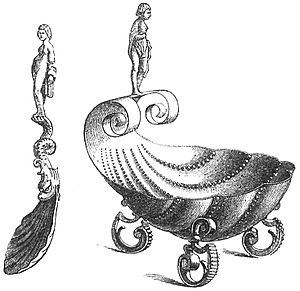Salt spoon facts for kids
A salt spoon is a very small utensil used to serve salt from an open dish called a salt cellar. Imagine a time before salt shakers, when salt didn't flow easily! Salt spoons were important then. They are usually about 2 to 3 inches (5 to 7.5 cm) long. Their tiny, round bowl is about 0.5 to 0.75 inches (1.25 to 2 cm) wide. You can find these spoons made from many materials. These include glass, silver, plastic, wood, ivory, bone, and even shell.
Salt spoons were also used as a measurement in old recipes. One salt spoon (often written as ssp) was equal to about 0.25 of a teaspoon. This is a little more than 1 milliliter.
Contents
Salt Spoons: A Tiny Tool for a Big Need
Salt is a very important seasoning for food. But long ago, salt would easily clump together. This happened because it absorbed moisture from the air. It wasn't like the free-flowing salt we use today. Because of this, people needed a special way to serve it.
Why Did People Use Salt Spoons?
Before modern salt, a lump of salt was put into a small dish. This dish was called an open salt, a salt cellar, or a master salt. Someone at the table would break up the salt lump. They might use a knife handle or another tool. Then, smaller amounts of salt were put into individual salt cellars. These small dishes often matched the larger "master" salt cellar.
What Are Salt Cellars?
Salt cellars are small containers designed to hold salt. They come in many shapes and sizes. Some were very fancy and beautiful. They were a common sight on dining tables for hundreds of years. People would use them to get their own portion of salt.
How Salt Spoons Were Used
Salt was a valuable seasoning. So, only small amounts were given to each person at the table. Diners had two main ways to use the salt. They could dip their food directly into their personal salt cellar. Or, they could use a tiny salt spoon. They would use the spoon to sprinkle the salt over their food. This made sure everyone got just the right amount.
From Spoon to Shaker
In the early 1930s, something big changed for salt. A new process was invented. This process coated each tiny grain of salt. It stopped the salt from sticking together. This meant salt could now flow freely! Because of this, the open salt cellar and its small salt spoon became less common. They were replaced by the everyday salt shaker we use today.
Collecting Salt Spoons Today
Even though they are not used as much now, salt spoons are still special. They are highly collectible items. Many people enjoy collecting these tiny pieces of history. You might even see them used today on some dining tables. They add a touch of nostalgia and old-fashioned charm.


